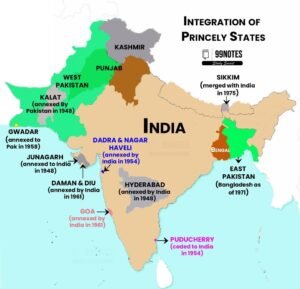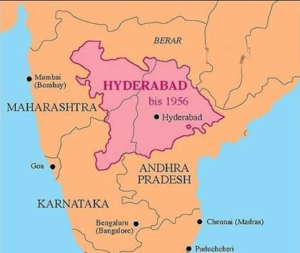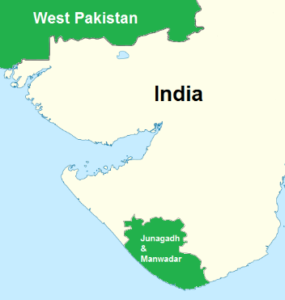UNIFICATION OF INDIA
 The unification process involved merging over 560 princely states, establishing a cohesive political framework, and fostering a sense of national identity among its people. It involved not only territorial integration but also the consolidation of democratic institutions, a unified legal framework, and a common economic policy.
The unification process involved merging over 560 princely states, establishing a cohesive political framework, and fostering a sense of national identity among its people. It involved not only territorial integration but also the consolidation of democratic institutions, a unified legal framework, and a common economic policy.
Role of Colonial Legacy
India’s political and territorial integration was deeply influenced by its colonial past. The British left behind a legacy of division and exploitation, which posed significant challenges to nation-building. However, the administrative and institutional frameworks established during colonial rule also provided a foundation for governance.
- Divide and Rule Policy: British policies of communal and regional division fostered mistrust and conflict among different communities. This complicated the task of post-independence political and social unity.
- Administrative framework: The British-established civil services, judiciary, and railways provided the foundation for India’s governance. However, colonial-era biases and inequities persisted within these structures.
- Territorial fragmentation: British policies, including the partition of Bengal (1905) and Punjab (1947), created complex territorial disputes. The separation of Burma (1937) further fractured India’s territorial integrity.
- Economic dependency: Colonial exploitation drained India’s resources, leaving the economy heavily dependent on British markets and imports. Post-independence economic policies aimed at self-reliance addressed this imbalance.
- Legal and political institutions: The British introduced parliamentary governance and a rule-of-law system. India adapted these frameworks to establish a democratic political structure under the Constitution.
Challenges in Unification (PYQ 2021)
After gaining independence in 1947, India faced the daunting task of unifying a diverse and fragmented nation. The challenges spanned across linguistic, religious, political, and economic dimensions, threatening national cohesion and stability. Overcoming these hurdles required strong political leadership and strategic policymaking.
- Linguistic diversity: India had over 1,600 languages and dialects, making communication and administration difficult. The demand for linguistic states led to tensions and protests, requiring careful political handling.
- Religious and communal tensions: The scars of partition fuelled deep communal divisions, leading to outbreaks of violence. The government promoted secularism and interfaith harmony to bridge these gaps.
- Princely states: Over 560 princely states needed to be integrated into the Indian Union. Sardar Patel led successful diplomatic and political efforts to unify them under a single constitutional framework.
- Economic disparity: Regional imbalances and widespread poverty created obstacles to balanced development. Economic planning and land reforms were introduced to reduce inequality.
- Political instability: Transitioning from colonial rule to a democratic framework caused political uncertainty. The adoption of the Constitution and the first general elections in 1952 helped stabilize the political landscape.
- Border conflicts: Unresolved territorial disputes with Pakistan and China created military tensions. Diplomatic and military measures were employed to safeguard national security and integrity.
Despite these challenges, India’s leadership under Jawaharlal Nehru, Sardar Patel, and Dr. B.R. Ambedkar laid the foundation for a unified and democratic republic. The successful integration of princely states, the adoption of a secular constitution, and the establishment of democratic institutions helped shape modern India’s national identity and political stability.
Integration of Princely States
At the time of India’s independence in 1947, the existence of 565 princely states under British paramountcy created a significant challenge for the newly independent Indian government. These states were not directly governed by British law but were bound by treaties with the British Crown. With the lapse of British paramountcy on August 15, 1947, the princely states were given the option to join India or Pakistan or remain independent. The political and territorial unity of India depended on the successful integration of these princely states, making it a complex and delicate task for the Indian leadership.
Pakistan or remain independent. The political and territorial unity of India depended on the successful integration of these princely states, making it a complex and delicate task for the Indian leadership.
Key Aspects of Integration
- Role of Sardar Patel and V.P. Menon: Sardar Vallabhbhai Patel and V.P. Menon led diplomatic efforts, convincing most princely states to sign the Instrument of Accession through negotiations and political pressure.
- Hyderabad Crisis: The Nizam of Hyderabad’s attempt to remain independent led to ‘Operation Polo’ in September 1948, where Indian forces annexed Hyderabad.
- Kashmir Issue: The Maharaja of Kashmir initially sought independence but later acceded to India in October 1947 after facing tribal invasions from Pakistan.
- Junagadh Dispute: The Nawab of Junagadh’s decision to join Pakistan despite its geographical location within India led to Indian military intervention and a plebiscite, resulting in Junagadh’s accession to India.
- Political Unification: The integration of princely states ensured the creation of a politically unified India, strengthening the foundation of the Indian Union.
The successful integration of the princely states was a remarkable achievement that laid the groundwork for India’s political and territorial unity. Sardar Patel’s strategic diplomacy and firm leadership ensured that India emerged as a cohesive nation-state, overcoming initial political and security challenges.
Methods of Integration
The integration of princely states into the Indian Union after independence was a complex and strategic process aimed at achieving national unity. It involved diplomatic negotiations, the use of the Instrument of Accession, and in some cases, military action to ensure a smooth merger. Sardar Vallabhbhai Patel played a pivotal role in leading this process, securing the accession of over 560 princely states.
1. Diplomatic Efforts and Political Negotiations
Sardar Patel’s diplomatic strategy involved persuasion, negotiation, and, where necessary, strategic pressure:
- Patel personally met with key princely rulers to address their political and security concerns, assuring them of their personal privileges and status under the new Indian administration.
- V.P. Menon played a crucial role in providing the administrative and legal framework to facilitate these negotiations and resolve conflicts arising from political differences.
- Patel offered incentives, such as guaranteed privy purses (financial compensation) and titles, to persuade the rulers to join the Indian Union voluntarily.
2. Instrument of Accession
The Instrument of Accession was a formal legal agreement drafted by V.P. Menon under the guidance of Sardar Vallabhbhai Patel:
- The princely states were given the option to accede to either India or Pakistan based on geographic location, political considerations, and the will of the people.
- The instrument allowed the states to retain control over certain internal matters such as culture, property, and succession while ceding powers over defence, foreign affairs, and communications to the central government.
- This framework ensured that the newly formed Indian Union could maintain national security and territorial integrity while respecting the historical autonomy of the princely states.
3. Military Action
The integration of Hyderabad, Junagadh, and Kashmir involved strategic diplomatic and military actions. In Hyderabad, after failed diplomatic negotiations with the Nizam, Patel launched Operation Polo in September 1948, resulting in a swift military annexation. In Junagadh, Patel combined diplomatic pressure with military intervention, followed by a plebiscite where the people voted to join India. In Kashmir, diplomatic efforts failed when Pakistan-backed forces invaded, leading to the Maharaja signing the Instrument of Accession in October 1947, which allowed India to deploy military forces to secure Kashmir.
4. Constitutional Adjustments and Political Accommodation
The integration process involved significant constitutional and administrative reforms to accommodate the political diversity of the princely states:
- The Indian Constitution provided a framework for governance that allowed states to retain linguistic and cultural identities while functioning under a unified federal structure.
- The concept of special status (e.g., Article 370 for Jammu and Kashmir) was introduced to address specific political and cultural concerns.
- Patel’s approach balanced federalism with central authority, ensuring that states retained a degree of political and administrative autonomy while being part of a strong national framework.
The successful use of the Instrument of Accession ensured that most princely states joined India voluntarily and peacefully. Patel’s diplomatic strategy combined with Menon’s legal and administrative expertise laid the foundation for India’s political stability and territorial integrity. The integration of princely states remains a landmark achievement in India’s post-independence history, demonstrating the effectiveness of balanced diplomacy and strategic political negotiation.
Difficult Cases of Integration
The integration of princely states into the Indian Union after independence was largely peaceful, but a few strategic and politically sensitive cases posed significant challenges. States like Hyderabad, Junagadh, and Kashmir created complex diplomatic and military challenges due to their geographic, political, and communal factors. Sardar Patel and V.P. Menon played a crucial role in resolving these cases through a combination of diplomacy, strategic pressure, and military action.
1. Hyderabad
 The integration of Hyderabad into the Indian Union was one of the most complex and sensitive challenges faced by the Indian government after independence. Hyderabad was the largest and most prosperous princely state, ruled by the Nizam, Mir Osman Ali Khan. Despite being surrounded by Indian territory, the Nizam sought to retain Hyderabad’s independence, leveraging its strategic location and vast resources to maintain a separate status. This created political and security concerns for the newly independent Indian government.
The integration of Hyderabad into the Indian Union was one of the most complex and sensitive challenges faced by the Indian government after independence. Hyderabad was the largest and most prosperous princely state, ruled by the Nizam, Mir Osman Ali Khan. Despite being surrounded by Indian territory, the Nizam sought to retain Hyderabad’s independence, leveraging its strategic location and vast resources to maintain a separate status. This created political and security concerns for the newly independent Indian government.
Key Aspects of Hyderabad’s Integration
- Resistance by the Nizam: The Nizam aimed to secure Hyderabad’s independence by seeking support from Pakistan and the United Nations while refusing to accede to India.
- Role of the Razakars: The Razakars, led by Kasim Razvi, supported the Nizam and carried out communal violence, targeting the Hindu population and increasing instability.
- Failed Negotiations: Efforts by the Indian government to resolve the issue through peaceful negotiations failed as the Nizam remained firm on his demand for independence.
- Operation Polo: In response to escalating violence, India launched a military operation, ‘Operation Polo,’ on September 13, 1948, under Major General J.N. Chaudhuri. Indian forces defeated the Razakars and secured Hyderabad within five days.
- Political and Administrative Integration: After the Nizam’s surrender on September 17, 1948, Hyderabad was brought under Indian control, and a temporary military administration was imposed to restore order.
The successful integration of Hyderabad demonstrated the decisive leadership of Sardar Patel and reinforced India’s territorial integrity. It marked a significant step in consolidating India’s political unity and overcoming the challenges posed by princely states after independence.
2. Junagadh
The integration of Junagadh into the Indian Union was a politically sensitive and diplomatically challenging task due to its strategic location and the Nawab’s controversial decision. Junagadh, located in present-day Gujarat, had a predominantly Hindu population but was ruled by a Muslim Nawab, Muhammad Mahabat Khanji III. After the lapse of British paramountcy in August 1947, the Nawab chose to accede to Pakistan despite Junagadh being geographically surrounded by Indian territory. This decision created tensions between India and Pakistan and sparked unrest among Junagadh’s  population.
population.
Key Aspects of Junagadh’s Integration
- Controversial Accession: The Nawab’s decision to join Pakistan, despite territorial contiguity with India, was seen as politically and strategically unacceptable by the Indian government.
- Public Unrest: Junagadh’s majority Hindu population opposed the Nawab’s decision, leading to civil disturbances and political instability.
- Military and Political Pressure: India responded by deploying troops to the border and encouraging local resistance against the Nawab’s decision.
- Flight of the Nawab: Under growing internal pressure, the Nawab fled to Pakistan in October 1947, leaving an administrative vacuum.
- Plebiscite and Merger: In December 1947, India held a plebiscite in which over 99% of voters chose to join India, legitimizing Junagadh’s integration into the Indian Union.
The peaceful resolution of the Junagadh issue through a democratic plebiscite highlighted India’s commitment to resolving territorial disputes through peaceful and democratic means. Sardar Patel’s firm political strategy ensured Junagadh’s smooth integration into the Indian Union, reinforcing India’s territorial integrity.
3. Kashmir
The accession of Kashmir to India was one of the most complex and contentious events in the process of India’s territorial integration after independence. At the time of partition, Kashmir was a princely state ruled by Maharaja Hari Singh, a Hindu ruler governing a majority Muslim population. Unlike other princely states, Maharaja Hari Singh initially sought to maintain Kashmir’s independence by signing standstill agreements with both India and Pakistan to preserve trade, communication, and administrative ties. However, this neutrality was soon challenged by external aggression.
Key Aspects of Kashmir’s Accession
 Tribal Invasion: In October 1947, Pakistan-backed Pashtun tribal forces invaded Kashmir, leading to large-scale violence, looting, and communal killings, which destabilized the region.
Tribal Invasion: In October 1947, Pakistan-backed Pashtun tribal forces invaded Kashmir, leading to large-scale violence, looting, and communal killings, which destabilized the region.- Maharaja’s Appeal for Help: Facing the threat of losing control over Kashmir, Maharaja Hari Singh sought military assistance from India to repel the invasion.
- Instrument of Accession: India agreed to provide military support only after Kashmir formally acceded to India. On October 26, 1947, Maharaja Hari Singh signed the Instrument of Accession, ceding control over defense, foreign affairs, and communications to India.
- Military Action: Indian troops were immediately airlifted to Srinagar, and military operations were launched to drive out the tribal forces and secure Kashmir.
- Ceasefire and Division: The conflict escalated into the First Indo-Pak War (1947–48). A UN-brokered ceasefire in January 1949 resulted in the division of Kashmir along the Line of Control (LoC) into Indian-administered Jammu and Kashmir and Pakistan-administered Azad Kashmir.
The accession of Kashmir strengthened India’s territorial integrity but also laid the foundation for a long-standing geopolitical conflict between India and Pakistan. The Kashmir dispute remains unresolved and continues to shape the security and political dynamics of South Asia.
Conclusion
India’s successful unification after independence ensured political and territorial stability through the integration of princely states, democratic governance, and a strong Constitution. Despite ongoing challenges like regionalism, communal tensions, and socio-economic disparities, India’s ability to balance federalism with central authority and accommodate diversity through democratic means remains a model for other post-colonial states. The commitment to democracy, secularism, and inclusive governance continues to uphold India’s national identity and unity.
Related FAQs of UNIFICATION OF INDIA
India was fragmented into over 560 princely states, each with the option to join India, Pakistan, or remain independent. Alongside religious and linguistic diversity, colonial legacies like the “divide and rule” policy made integration politically and socially complex.
Sardar Patel, along with V.P. Menon, led the diplomatic and strategic efforts to unify the princely states using the Instrument of Accession. He resolved tough cases like Hyderabad, Junagadh, and Kashmir through a mix of negotiation and military action.
The Nizam wanted independence and supported the Razakars, leading to violence. When talks failed, India launched Operation Polo in 1948, quickly annexing Hyderabad and integrating it into the Union.
The Nawab of Junagadh joined Pakistan despite being surrounded by Indian territory. After public unrest and the Nawab fleeing to Pakistan, India held a plebiscite in 1947 where over 99% voted to join India.
Kashmir’s Hindu ruler signed the Instrument of Accession with India after Pakistan-backed tribal invasion. This led to the First Indo-Pak War and a UN-mediated ceasefire, dividing the region. The dispute remains unresolved and fuels ongoing India-Pakistan tensions.


